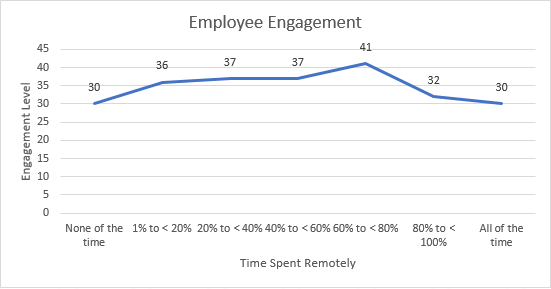Remote Work and Employee Engagement
COVID-19 crisis promoted remote work as one of the top workplace trends in the previous year. It changed the way how people work, communicate, collaborate, and engage in their work.
At the first glance, you might think that remote workers are less engaged than their peers who are physically present in the workplace. However, this assumption is not very accurate.
Giving employees to work remotely part of the time increases their engagement because they perceive it as flexibility in their working conditions. On the other side employees who work remotely all the time, or never work remotely are less likely to be engaged.
According to a Gallup study, those who spend 60% to 80% of their time working remotely are the most likely to be engaged. And the less time they spend in the office, the more progress they say they make.
The below chart shows the relationship between the tie spent working remotely and employee engagement level:1

The challenge of remote employee engagement is that it is a different game with different rules. Remote work gives employees two key benefits freedom and flexibility.
Remote workers save a lot of time that would have been lost in commuting from and to work, which allows them to devote more time and energy to their families, hobbies, personal development. And as long as their performance is satisfactory, they can create their own schedules and work whatever hours meet their needs.
Traditional engagement activities are not best suited for remote employees especially if they are time-sensitive. It will only eat into their freedom, especially if your teams are spread out across different time zones.
Happy hour, zoom fun time, happiness at work webinar might seem very cool ideas for engaging remote workers, but it could negatively affect your employees unless it has a clear purpose and expectations around participation. For some people being forced to attend such activities means only that they have to stop working on something very critical to their success. For others, it means that they have to skip family gatherings or to work during unfavorable hours.
In a remote setting, employees should not feel like they are being forced to participate in mandatory activities that distract them from things they would rather be doing. Instead, they should be free to engage in their schedules and they should always be willful participants.
Once you begin viewing employee engagement through this lens, the endeavor becomes less about "How can we help employees feel more connected?" and more about "What does each employee need right now?"
There are three major strategies that you should keep in mind when designing engagement activities for remote employees:
1. Recognize their individuality2
Treat every employee as a separate individual who has a unique personality, needs, and preferences. Engage in one-on-one personal conversations with employees. Those conversations are not part of daily standups or performance reviews. Those conversations should be focused on the human side of your employee's needs.
During these chats, seek to understand each remote worker’s mindset, goals, triumphs, and challenges. Ask questions about their personal and professional growth, productivity, well-being, and progress.
Listen carefully and genuinely to them, ask how can we make your work experience better, offer support and real solutions.
2. Connect through commonalities2
Although employees have individual differences that we should look at carefully when designing engagement activities, those individuals have a lot of commonalities that we can use to gather them together. In 2020 Isolation and lack of connectedness was ranked the number one challenge facing remote teams according to a survey done by Buffer on 3521 remote worker.3
To create commonalities-based connectedness try to unify employees around the same cause, values, and purpose. In a traditional office setting, it is easy to put posters all over the office reminding employees of company values, mission, vision, and so on. But it is not that easy with remote workers. Your communication through every phone call, email, or Slack message should reflect those core values of the company, this will remind employees that they are always part of something bigger than their own goals.
Another tip to create the commonalities state is through collectibles. Think about the giveaways you receive in any event! Help your employees fill their home workspaces with company-branded pens, notebooks, stress balls, lamps, stickers, and any other stuff that can remind them of the commonality and belonging.
3. Cultivate clear communication
In the previously mentioned survey, communication and collaboration ranked almost the same as loneliness as the second most common challenge – both of them scored 20%.
Text messages and emails are the most common communication channels used by remote workers. A lot of the nuance of face-to-face conversations can be lost though.
Here are some tips to help your communication become clearer:
- schedule check-ins
- Use video conferencing whenever possible
- Keeps meetings short and to the point
- Don’t discuss more than one to three topics at a meeting
- Assign one of the team members as meeting moderator
- Take notes for documentation
- Use visual presentations as much as possible
- Invest in collaborative software
1Adam Hickman, Jennifer Robison 2020, Gallup, accessed 2 Feb 2021,
2 Ryan Chartrand 2020, Business.com, accessed 2 Feb 2021,
3Buffer.com 2020, accessed 2 Feb 2021,
For more about this topic, download our latest book "Engage Your Employees in Valentine's Day" for FREE:
